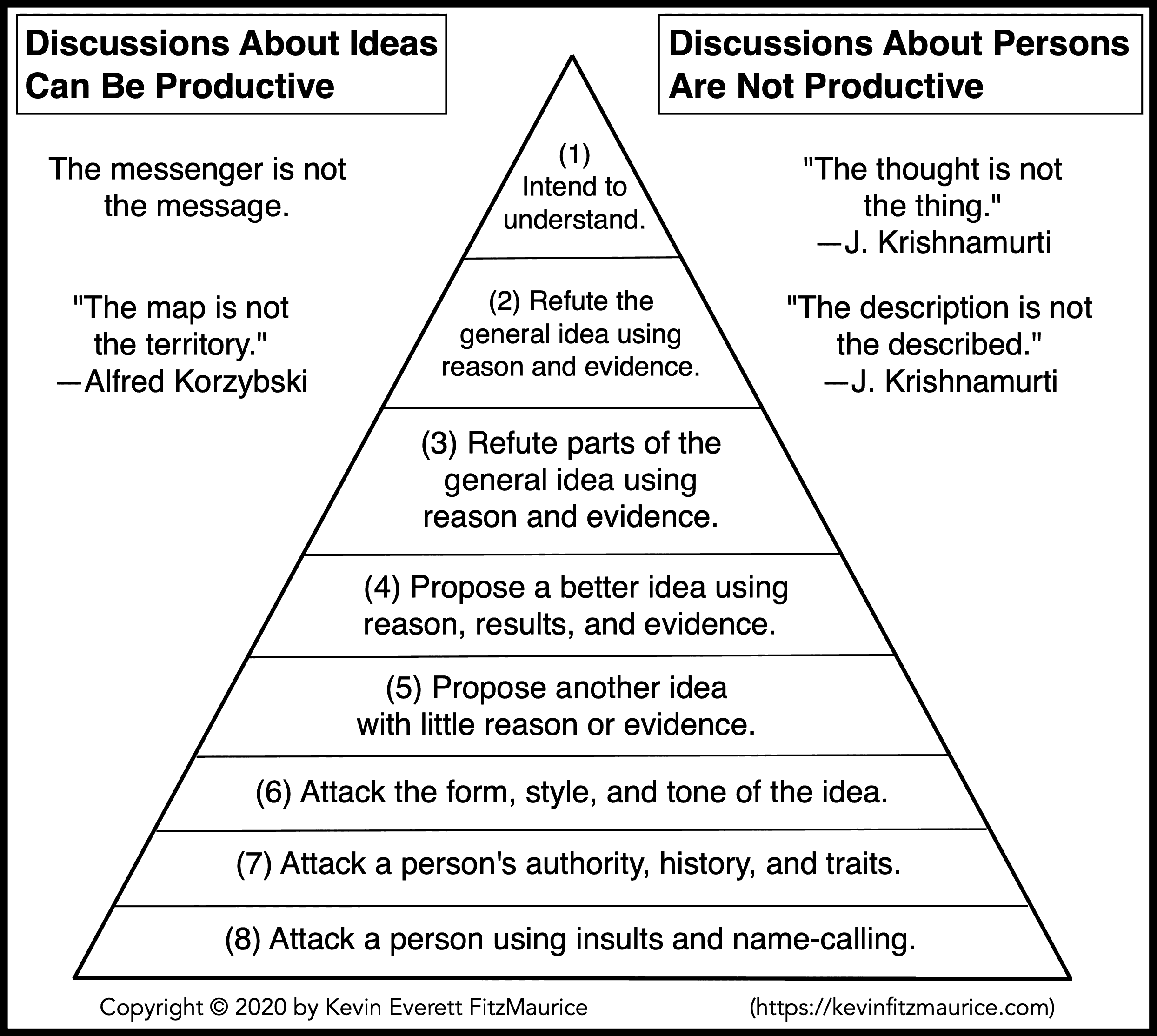Discuss IdeasDiagramSteps 1–4Steps 5–8Related Pages6 Groups of Topics10 Skills & Topics
How To Discuss Ideas Instead of People
- Attitude Is All You Need! Second Edition will help you to improve your attitude, which improves everything else.
Discuss ideas, not people. This page lists a hierarchy of approaches to discussing Ideas with people. The lower levels should be avoided.
“Great minds discuss ideas; average minds discuss events; small minds discuss people.” —Eleanor Roosevelt
- Read and discover the best diagrams and maps of how people control and manipulate you.
Discuss Ideas: Diagram of 8 Levels of Quality for Communication
- Information on the five thinking positions (the way to gain perspective).
- Read and discover the best diagrams and maps of how people control and manipulate you.
Discuss Ideas: Diagram Explained
- This diagram is a useful guide for having discussions.
- The diagram is hierarchical; this means the best strategy is at the top, and the worst is at the bottom.
- You can use it to know when a discussion has gone bad and it is time to leave it.
- You can use it to encourage yourself and others to have productive discussions.
- The lower levels dominate the Internet.
Discuss Ideas: Diagram Developed: Step One
- Intending to learn is the highest mental state you can bring to a discussion.
- Intending to learn can disarm those who seek conflict to increase their pride.
Discuss Ideas: Diagram Developed: Step Two
- Focusing on a general idea helps to keep the discussion interesting and useful.
- Challenging the opposite or other person’s general idea must be done correctly.
- Challenge and refute by providing reasons why the general idea is flawed.
- Challenge and refute by providing evidence (results if you have them) as to why the general idea is flawed.
Discuss Ideas: Diagram Developed: Step Three
- Focusing on a part of a general idea can only work if there is an agreement to focus on that part.
- Challenging the part of the general idea needs to be done correctly.
- Challenge and refute by explaining why some of the general idea is flawed.
- Challenge and refute by providing evidence (results if you have them) why some part of the general idea is flawed.
Discuss Ideas: Diagram Developed: Step Four
- Sometimes, the best way to refute one idea is to propose a better idea.
- However, better ideas require more reasons and various proofs than objections to the same idea.
- Better ideas require lots of proof, evidence, and reasons.
- If possible, provide a comparison of results using statistics.
- Anecdotal evidence is interesting, but it fails to prove anything.
- Read and discover the best diagrams and maps of how people control and manipulate you.
Discuss Ideas: Diagram Developed: Step Five
- This is the last level of hope for a productive conversation.
- It would help to redirect the conversation to one of the higher levels.
- This level does not have to be negative but cannot be productive.
- Expecting that an idea will be better does not make it better.
- Providing anecdotal evidence proves nothing. Learn to use statistics for comparisons.
Discuss Ideas: Diagram Developed: Step Six
- Attacking the idea’s form, style, or tone is not to attack the idea at all.
- This is not a productive or helpful practice.
- This is usually insulting and done to boost the pride of the attacking person.
- Often, scoffers and mockers stoop to this level using sarcasm or crude humor.
Discuss Ideas: Diagram Developed: Step Seven
- Attacking a person’s authority, character, history, and traits completely avoids the issue of the idea’s value.
- The messenger is not the message.
- Pretend you do not know the idea’s source and face it on its own merits.
- Disvaluing the messenger does not disvalue the message.
Discuss Ideas: Diagram Developed: Step Eight
Attaching a person using insults and name-calling is emotional abuse.
- This is violence and should not be tolerated.
- Leave such conversations if at all possible.
- Never respond in kind because, to these silly people, that proves they were right.
- This is an ego game, and there are only winners and losers.
Discuss Ideas
3D: Daily Dose: 2020
#Idea #Not: 2020-08-18
- The idea about the idea is not the idea.
- The explanation of the idea is not the idea.
- The discussion about the idea is not the idea.
- The comparison of the idea with other ideas is not the idea.
- The college course, lecture, and textbook on the idea is not the idea.
- Read and discover the best diagrams and maps of how people control and manipulate you.
Discuss Ideas: Related Pages
- Communication: Memes Teach How to Communicate
- Communication Skills: Free Help
- Difficult People: How to Handle
- Don’t Argue Reality
- Ego Maintains Fights
- Empathic to Narcissistic: 5 Styles Using 5TP
- “I” Statements for Less Conflict
- “I” Statements: Advanced Version
- Messenger & Message Problem
- Passive to Aggressive: 5 Styles Using 5TP
- Relational Styles: 25 Based on 5 Thinking Positions
- Read to discover maps and diagrams about how people use and abuse you.
- Read and master the life skill of acceptance using the best combination of CBT, REBT, & Stoicism.
Discuss Ideas: 6 Groups of Topics Menu
- 1. Pages by Topic
- 2. Fast-Facts by Topic
- 3. Quotations by Topic
- 4. Poems by Topic
- 5. Scripture by Topic
- 6. Websites by Topic
- Read and master the life skill of acceptance using the best combination of CBT, REBT, & Stoicism.
- Read for the best breathing exercises for your feelings and stress.
- Read and discover the best diagrams and maps of how people control and manipulate you.
Discuss Ideas: 9 Skills & Topics Menu
- 1. Anger Skills & Topics
- 2. Blame Skills & Topics
- 3. Communication Skills & Topics
- 4. Coping Skills & Topics
- 5. Counseling Skills & Topics
- 6. Praying Skills & Topics
- 7. Recovery Skills & Topics
- 8. Responsibility Skills & Topics
- 9. Thinking Skills & Topics
- Read and master the life skill of acceptance using the best combination of CBT, REBT, & Stoicism.
- Read for the best breathing exercises for your feelings and stress.
- Read and discover the best diagrams and maps of how people control and manipulate you.





